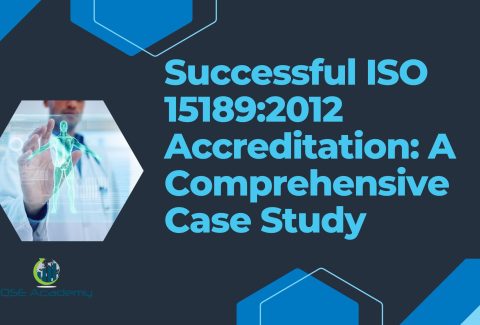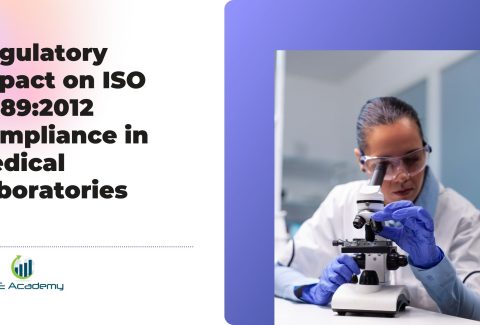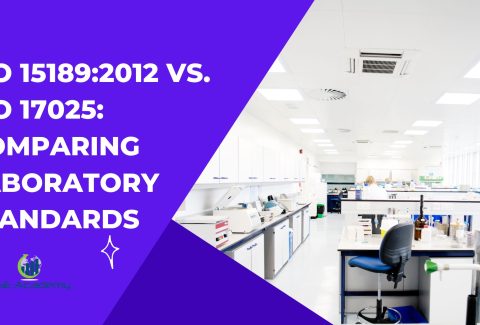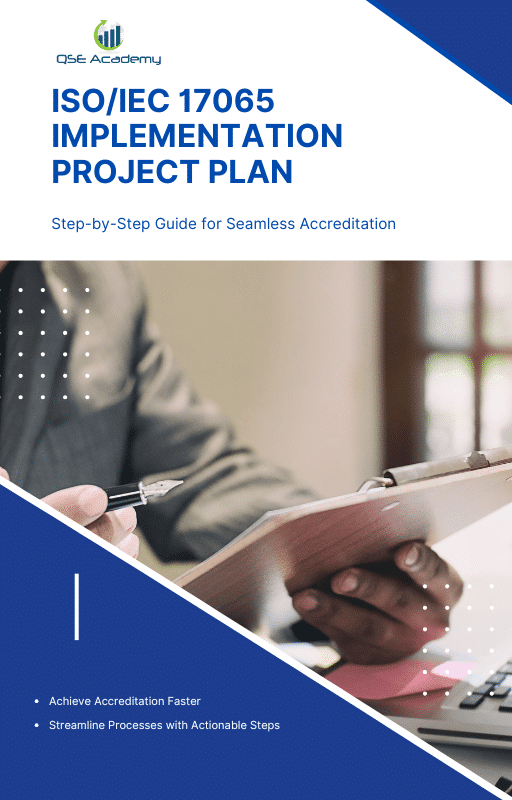Crafting a Comprehensive Quality Manual for ISO/IEC 17065 Compliance
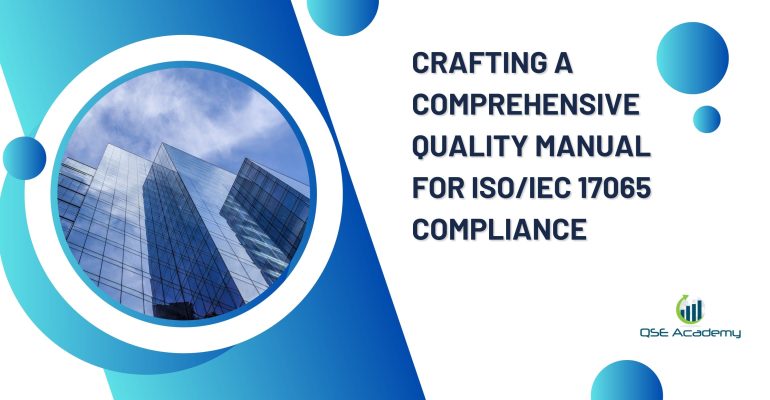
Realizzazione di un manuale della qualità completo per la conformità ISO/IEC 17065
In the world of product certification, ISO/IEC 17065 is the key to unlocking international trust and compliance. Before one can begin preparing for ISO/IEC 17065 accreditation, it’s critical to understand the role of a comprehensive quality manual. This article is set to guide organizations through the creation of such a pivotal document.
From delineating the purpose and scope, to breaking down the essential components, the manual is far more than just a stack of procedures—it’s the blueprint for consistent quality management. We intend to walk you through every necessary step, demystify the complexities, and offer solutions to the problems you might encounter along the way.
Introduzione
ISO/IEC 17065:2012 is an internationally recognized standard that outlines the requirements for bodies certifying products, processes, and services. Its main objective is to ensure that certification bodies operate in a competent, consistent, and impartial manner. This standard provides a framework for certification bodies to ensure fairness in the certification process and fosters trust among consumers and stakeholders in the certification of products.
The quality manual plays a pivotal role in ISO/IEC 17065 compliance. It documents the structured and systematic processes a certification body implements to manage its operations and meet the standard’s requirements. This manual is central to the effective management and control of certification activities, ensuring transparency and consistency.
ISO/IEC 17065 has evolved from its predecessors, including the ISO/IEC Guide 65, to incorporate the latest best practices in conformity assessment and certification requirements. The standard sets a global benchmark for quality management systems affecting a diverse array of sectors, including the intricate food production processes.
By leveraging a robust quality manual, certification bodies can effectively address the requirements specified in ISO/IEC 17065, including management review, internal audits, and corrective and preventive actions. This contributes towards streamlined certification agreements and establishes a credible certification decision pathway.
Capire lo scopo e la portata di un manuale della qualità
The purpose of a Quality Manual in the sphere of certification bodies, which comply with ISO/IEC 17065, is multifaceted. Primarily, it serves to ensure that the certification activities — encompassing everything from the certification of products to making a certification decision — are performed consistently and reliably. By establishing a clear protocol based on the international standard, a certification body provides assurance to stakeholders that its services are of high quality and credibility.
In addition to promoting consistency, a Quality Manual is an integral tool for demonstrating a certification body’s adherence to the rigorous requirements set forth by ISO/IEC 17065:2012. Through the manual, a certification body showcases its commitment to operating by the standard’s stipulations, including management systems, conformity assessment activities, and scheme requirements.
Audit checklist inclusion and the manual’s utility in steering continuous improvement cannot be understated. The manual acts as a map for both internal audits and reviews by accreditation bodies, simplifying the evaluation process and aid in identifying areas for Corrective and Preventive actions.
The scope of a Quality Manual extends to the definition of the extent of certification activities and lays out the certification requirements. It describes the structural framework of the organization, detailing roles, authorities, and responsibilities, and it also demarcates the boundaries of the quality management system. This clarity in scope is vital for the formulation of clear policies and objectives, compliance with accreditation requirements, and ensuring proper conduct of certification activities within prescribed parameters.
Componenti fondamentali del Manuale della qualità
The quality manual serves as a cornerstone for organizations seeking accreditation to ISO/IEC 17065, setting out the company’s commitment to certifying products reliably, impartially, and in accordance with stated certification requirements. It embraces the core components crucial to the competent operation of a certification body.
Quality Policy and Objectives: The manual must articulate a clear quality policy demonstrating the organization’s intent to operate with integrity in its certification activities. This policy forms the foundation of measurable quality objectives, establishing a framework for continuous improvement and ensuring alignment with the requirements for bodies certifying products, services, and processes.
Struttura organizzativa: A well-defined organizational structure is essential. An organizational chart should identify key personnel, their roles, and responsibilities. The hierarchy outlined should support the certification decision process, endorsing a structure conducive to impartial certifications.
Controllo dei documenti: Robust procedures are necessary to manage document control. These should address creation, approval, version control, distribution, and the retention and disposal of records, thus preventing excessive paperwork and ensuring control of records in line with ISO/IEC 17065.
Gestione dell'imparzialità: The manual must detail stringent policies ensuring impartiality, preemptively addressing potential conflicts of interest. Regular monitoring and reviews bolster these efforts, ensuring continued adherence to the accreditation requirements and preserving the integrity of the certification process.

Procedure e processi dettagliati
ISO/IEC 17065 quality manual guidelines establish rigorous processes to ensure that certification bodies operate impartially, competently, and consistently. Certification bodies must have detailed procedures in place for application, evaluation, decision-making, and surveillance to maintain accreditation and foster trust in their certification activities.
Processo di candidatura Certification bodies must define the submission and review procedures clearly, stipulate the criteria for accepting or rejecting applications, and specify the documentation required from applicants. This ensures a transparent pathway for applicants aiming to certify their products, processes, or services.
Processo di valutazione Detailed methods and criteria for evaluations are crucial. Certification bodies are required to meticulously document evaluation results, thereby upholding the integrity of the certification process and ensuring the reliability of the certifications granted.
Processo decisionale The certification body must establish criteria and procedures for making certification decisions. Impartiality is paramount, necessitating clear documentation of decisions and the rationale behind them to maintain credibility and transparency.
Sorveglianza e ricertificazione Surveillance audits and recertification processes must be defined to monitor continuous compliance. Certification bodies should implement standards for monitoring and maintaining the validity of certifications, thus ensuring ongoing trust in the certified entities.
Handling Changes and Non-Conformities Change management and non-conformity resolution procedures, including corrective and preventive actions, should be in place to address discrepancies and drive continuous improvement within the certification body.
Reclami e ricorsi A process to handle complaints and an appeals process for certification decisions should be clearly defined and documented, ensuring issues are resolved efficiently and fairly.
Supporting Processes and Documentation
To ensure compliance with ISO/IEC 17065, certification bodies must establish meticulous supporting processes and maintain thorough documentation. This encompasses structuring internal audits, management reviews, and resource management that align with the stipulated international standard.
Internal audits are essential in assessing the efficacy of the certification process. Certification bodies are required to develop comprehensive internal audit schedules and clearly define procedures. It is crucial to document audit findings meticulously and implement corrective actions as necessary. Follow-up and verification processes must be in place to monitor the efficacy of these actions.
Management reviews serve as a systematic examination of the certification activities and the overarching management systems. Adopting a structured approach to management review procedures, including setting agendas, documenting review meetings, and tracking action items, ensures continual improvement and responsiveness to any emerging issues or changes in scheme requirements.
Effective resource management is critical in maintaining the quality of certification activities. The certification body must keep records of competence and provide adequate training to personnel. The maintenance of infrastructure and facilities, along with the prudent allocation and management of resources, is essential for meeting certification requirements and performing conformity assessment activities efficiently.
|
Supporting Process |
Requisiti chiave per la documentazione |
|---|---|
|
Audit interni |
Audit schedules, procedures, findings, corrective actions, follow-up |
|
Recensioni sulla gestione |
Review procedures, agendas, meeting documents, action items |
|
Gestione delle risorse |
Competence and training records, infrastructure maintenance |
Migliori pratiche per lo sviluppo e la manutenzione del manuale della qualità
Developing and maintaining a quality manual in compliance with ISO 17065 is an essential task for certification bodies to manage certification activities effectively. Best practices for the development of the Quality Manual include involving key stakeholders in the process to ensure a collective understanding of the manual’s content and purpose. Utilizing templates and checklists can help guarantee that the manual addresses all the necessary accreditation requirements, certification of products, and certification decision processes. Clarity and accessibility must be prioritized to ensure that relevant parties can easily interpret and apply the guidelines.
To maintain the integrity of the Quality Manual, certification bodies should establish regular review and update schedules, aligning procedures with any feedback received or changes in standards, such as updates to ISO/IEC 17065:2012 or ISO/IEC Guide. Staff should be adequately trained on the content of the Quality Manual, including any revisions, to facilitate seamless conformity assessment activities.
Leveraging technology can greatly enhance the management of the Quality Manual. Document management systems can provide controlled access, automatic version control, and secure storage. Digital accessibility and automated distribution mechanisms ensure that personnel have the latest information, thus streamlining the certification process and reducing the risk of excessive paperwork or errors due to outdated information.
Sfide e soluzioni comuni
Ensuring Consistency Across Documentation
One of the principal challenges certification bodies face is the necessity to maintain consistency across all forms of documentation. Achieving this requires the standardization of document formats and templates to ensure a uniform appearance and structure. This not only lends a professional look to the documents but also simplifies understanding and review processes. To facilitate consistency, it is imperative that staff are adequately educated on documentation standards. Hands-on training sessions and workshops can arm staff with the knowledge to uphold these standards, thereby preventing deviations that could compromise the integrity of documentation.
Managing Large Volumes of Documentation
Certification bodies typically handle vast amounts of paperwork, including audit checklists, certification agreements, and control of records. Effective document organization is crucial; this could involve categorizing documents by type, purpose, or process. Moreover, these organizations can benefit greatly from leveraging technology. Implementing document management systems can streamline the sorting, filing, and retrieval of documents. By using such technologies, the certification process becomes more efficient, and the risk of errors or lost paperwork is substantially reduced. Furthermore, these systems often incorporate features for real-time collaboration and version control, thus further enhancing the management of documentation.
| Sfida | Soluzione |
|---|---|
|
Consistency Across Documentation |
– Standardized templates – Staff training |
|
Managing Large Volumes of Records |
– Effective organization methods – Technology leverage |
Key Takeaway: Implementing standard procedures and embracing technological solutions are crucial steps in overcoming the challenges associated with the management of extensive certification documentation.
Casi di studio ed esempi
Caso di studio 1: Organismo di certificazione della produzione
A manufacturing certification body undertook the implementation of a quality manual consistent with ISO/IEC 17065 requirements. The development process involved identifying the specific certification of products and aligning procedures with international standard benchmarks. Challenges included streamlining complex procedures to minimize excessive paperwork and cost in document preparation. Solutions such as adopting digital management systems for control of records and automating parts of the certification process were implemented. The results led to a more efficient certification decision process, with the impact being improved accuracy in conformity assessment activities and enhanced reputation among accreditation bodies.
Caso di studio 2: Organismo di certificazione basato sui servizi
For a service-based certification body involved in food production processes, the quality manual development entailed adapting ISO/IEC 17065:2012 to service-specific nuances. Challenges here were twofold: ensuring the manual met the diverse certification requirements of various services and simplifying its usability to avoid deterrence due to complexity. The body introduced a streamlined audit checklist and focused training sessions on corrective and preventive actions. Outcomes of this included quicker management review times, consistency in certification activities, and stronger compliance with scheme requirements. The quality manual update enhanced overall certification quality and facilitated the retention of accreditation status.
Both cases exhibit how tailored approaches to quality manual implementation can surmount industry-specific hurdles and bolster the credibility and efficiency of certification bodies.
Conclusione
A quality manual is a critical document for certification bodies aiming to comply with ISO/IEC 17065. It encapsulates the organization’s processes and demonstrates how the certification body meets the requirements for bodies certifying products, processes, and services. The manual serves as a foundational directive for internal audits, management reviews, and consistent certification decisions. The effective implementation of the manual ensures that the body adheres to international standards while reducing the cost in document preparation and minimizing excessive paperwork.
In summary, the quality manual must align with the structure and content outlined in ISO/IEC 17065:2012. It requires clear documentation of the certification process, resource and structural requirements, and control of records, alongside provisions for corrective and preventive actions. The trend in quality management for certification bodies is shifting towards integrating technology to streamline certification activities and enhance conformity assessment activities. This evolution underscores the importance of maintaining a quality manual that is not only compliant with current standards but also adaptable to future accreditation requirements and scheme requirements.
For certification bodies, a comprehensive quality manual is not a mere requirement but a strategic tool that fosters transparency, accountability, and continuous improvement, thus facilitating accreditation by recognized accreditation bodies and underpinning trust in certification agreements.
Riferimenti
When developing an ISO/IEC 17065 quality manual, it’s vital to consult a number of authoritative sources to ensure that the manual meets the requirements of the international standard. Key sources include:
- ISO/IEC 17065:2012: The primary standard that outlines the requirements for bodies certifying products, processes, and services. This document provides comprehensive guidance on the certification body’s general requirements, structural requirements, resource requirements, and the certification process and management system requirements.
- ISO/IEC 17021: While this standard focuses on requirements for bodies providing audit and certification of management systems, it offers valuable information on conforming to general principles relevant to certification bodies.
- Guida ISO/IEC 65: This is the predecessor to ISO/IEC 17065 and provides a foundation for understanding the evolutionary context of the standard.
- IAF (International Accreditation Forum) documents: These offer insights into specialized areas of accreditation and detailed interpretations of the standards.
For industry-specific guidelines, refer to additional documents that may include sector-specific scheme requirements, details about control of records, and advice on implementing preventive and corrective actions.
Table: Key ISO References for Manuale della qualità Costruzione
|
Document Title |
Descrizione |
Area di interesse |
|---|---|---|
|
ISO/IEC 17065:2012 |
Requisiti per gli organismi che certificano prodotti, processi e servizi |
Certification Requirements |
|
ISO/IEC 17021 |
Audit and certification of management systems |
Sistemi di gestione |
|
Guida ISO/IEC 65 |
Predecessor to ISO/IEC 17065 |
Historical Context |
|
IAF Documents |
Interpretations and specialized accreditation guidance |
Accreditation Body Guidance |
For practical application, create an audit checklist aligning with these references to facilitate internal audits and management reviews. These practices help ensure compliance without excessive paperwork or cost in document preparation, especially in complexities like food production processes.
Ulteriori letture:
- “Conformity Assessment – Requirements for Bodies Certifying Products, Processes, and Services”: Provides insights into ISO/IEC 17065.
- IAF Guidance on the Application of ISO/IEC 17065: Clarifies the application of the standard for accreditation bodies and certification bodies.
Appendice
An appendix to a quality manual can serve as an essential resource for certification bodies seeking accreditation under ISO/IEC 17065 for the certification of products. It may contain supplementary materials such as templates, checklists, and references that assist in streamlining the accreditation and certification process, ensuring that none of the ISO/IEC 17065 requirements are overlooked.
Modelli e liste di controllo:
- Quality Manual Development
- Lista di controllo per l'audit
- Revisione della gestione
- Decisione di certificazione
- Azioni correttive e preventive
Programmi di formazione e certificazione:
- Accreditation Body Requirements
- Certification Agreements
- Certification Requirements and Activities
- International Standard Compliance
- Quality Management Systems Fundamentals
The appendix might also include links to training programs for internal audits, control of records, and conformity assessment activities, which uphold the structural and resource requirements stipulated by the standard. Furthermore, it aids in addressing the accreditation requirements, such as defining the types of management systems needed or detailing food production process certifications, while minimizing the cost in document preparation and excessive paperwork.
When designing a quality manual, it’s critical to remember that the appendix should not just be an afterthought but rather an integral component that provides practical assistance in meeting ISO/IEC 17065:2012 and ISO/IEC 17021 standards.
Cercate altre risorse sulla ISO 17065?
Se questo articolo vi è stato utile, esplorate le nostre risorse premium progettate per aiutarvi a ottenere la certificazione ISO 17025 in modo efficiente:
- 📦 Pacchetto completo di documentazione per ISO/IEC 17065 2012: Ottenete tutti i modelli e i documenti essenziali di cui avete bisogno per un'implementazione facile e veloce.
- 🎓 Corso online su ISO/IEC 17065 2012 : Iscrivetevi alla nostra formazione completa per acquisire i concetti chiave e i passi pratici per ottenere la certificazione.
- 📋 Lista di controllo ISO/IEC 17065 2012: Scaricate la nostra lista di controllo dettagliata per assicurarvi di aver coperto ogni fase del processo.
Queste risorse sono state studiate su misura per soddisfare le vostre esigenze e garantire un percorso di certificazione senza intoppi. Esplorateli oggi stesso e fate un passo avanti verso il successo!

